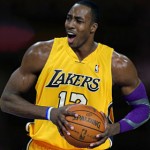 Figures lie and liars figure.
Figures lie and liars figure.
I remember when I asked my accountant how much I made from my investments one year and his answer was, “How much do you want to make?” Then he dropped the line above. I don’t mean that he was a crooked accountant. As a matter of fact, the opposite was true. His reputation was so good that his clients were almost never audited.
The point was that you can use statistics to prove whatever you want them to prove.
With the success of using analytics in baseball, the current generation has tried to apply the same philosophy to basketball. Teams now have entire staffs in place to measure and analyze performance. It is amazing how many coaches started as video coordinators.
This has given birth to complicated formulas with names like Adjusted Plus/Minus, Player Efficiency Rating and Win Shares per 48 Minutes.
 Each of these measures try to use reductionist science to describe a holistic experience. In a nutshell these stats try to take a complicated moving machine and define it as the sum of its parts. And the current thinking is to take these mathematical gymnastics and use them to pick your team, call your plays and make substitutions.
Each of these measures try to use reductionist science to describe a holistic experience. In a nutshell these stats try to take a complicated moving machine and define it as the sum of its parts. And the current thinking is to take these mathematical gymnastics and use them to pick your team, call your plays and make substitutions.
They are used in an attempt to define a player’s usefulness on the court. With statistics to measure his production, teams will in theory have a measure that can be used to compare players in an “apples to apples” environment.
Remember the words “in theory.”
There is nothing new about the approach; what’s new is the level of technology. Since the beginning of sports, players have been judged by their stats. Players have been described as “selfish” for looking at the stat sheet after games. And the truth is that players get paid in relation to the production that is measured by the stat sheet.
The problem is how to make this entire mind-numbing exercise useful.
Allen Iverson would score 34 points by going 9-of-28 from the field with four threes and multiple trips to the line. Did that help you win? Bill Russell averaged 15 points a game for his career, shooting just 44 percent from the floor and 56 percent from the line. What did Red Auerbach see in him that made him the best winner of all time? Red didn’t have metrics. Would Russell have been the same player if he played for the Knicks?
 I remember when I was with the Nuggets in the mid 1980s and our coach, Doug Moe, was discussing whom to draft with our GM, Pete Babcock. Pete is a very thorough guy and a leader in analyzing advanced stats. Doug, on the other hand, coached entirely by feel. Pete was discussing the skill set and attributes of a specific player he wanted to draft and Doug would ask, “Can he play?” Pete would describe his shooting ability, his per-minute output and Doug would say, “Yeah, but can he play?”
I remember when I was with the Nuggets in the mid 1980s and our coach, Doug Moe, was discussing whom to draft with our GM, Pete Babcock. Pete is a very thorough guy and a leader in analyzing advanced stats. Doug, on the other hand, coached entirely by feel. Pete was discussing the skill set and attributes of a specific player he wanted to draft and Doug would ask, “Can he play?” Pete would describe his shooting ability, his per-minute output and Doug would say, “Yeah, but can he play?”
Doug was famous for playing a high-scoring, passing game offense that required players who knew how to read the game as it was happening and make plays. He could care less about per-minute rebounds, pick-and-roll percentages or sink-and-fill ratios. His focus was on his players’ ability to play together. He and Pete were a great complement to each other as each focused on different elements, intangibles vs. tangibles.
When I was with the Orlando Magic in 1998, digital video was all the rage. For the first time, the team could get game highlights edited to view by halftime. Assistant coach Tom Sterner was a wiz at the tech stuff. We had all of the scouting reports in elaborate databases, and the video archiving was extensive. He was in his office morning and night working on the data.
One day he was showing me all the “Gee whiz” things that the system could do. I am a fairly bright guy and understood it all. Then I asked him, “How does this get us a basket?” He was kind of put off and felt that I didn’t appreciate the coolness of it all. I told him that I got the coolness but needed more clarity on the usefulness.
What I see today is the pendulum swinging to the stats becoming more important than they really are. While all of this brain damage has its place and is a valuable tool, it is fundamentally flawed. Firstly, all formulas are biased. You can’t define a truly dynamic, flowing game in a math equation.
 Baseball is essentially a series of stop-action plays made in a one-on-one fashion. It really lends itself to metrics. Basketball, however, is the opposite.
Baseball is essentially a series of stop-action plays made in a one-on-one fashion. It really lends itself to metrics. Basketball, however, is the opposite.
For example, each pick-and-roll has eight other guys who can influence the outcome. How useful is measuring that to two decimal points? Rebound percentage is a factor of who is on the floor competing for rebounds. Dwight Howard on a team with all shooters has a huge rebounding percentage, because there isn’t another guy on the floor who can rebound. How do you compare that with a guy on a team which uses three bigs?
I was a guy that never produced big stats but made the guys around me better. How do you measure helping on defense, clogging the middle, boxing out so your teammate can get the rebound, setting a weakside pick to get a guy open and all the other little things that aren’t measured on a stat sheet.
Also, no formula measures the intangibles. Things like commitment, heart and making a hustle play are all keys to winning. Basketball IQ and team synergy are by far the most important elements – and the most difficult to measure.
While I think that metrics are an important piece of the puzzle, they are only a piece. Their best use is to support or refute a belief that you have. Using it for more than that is – in my opinion – the tail wagging the dog.
The Miami Heat are one of the teams that uses metrics the most. The reason they won the championship last season was because of Ray Allen’s big heart, LeBron James’ will to win and Gregg Popovich’s cranial flatulence. Where does that show up on the stat sheet?
The things that make a player and the game great – heart, inspiration, teamwork and the other intangibles – cannot be measured in a formula. The skill to acquire and mesh players with these abilities will always be an art, not a science.
MORE FROM DANNY SCHAYES:
10 PREDICTIONS FOR THE 2013-14 SEASON
WHEN ROOKIE HAZING WENT UNDERGROUND
CAN CHRIS PAUL LEAD THE NBPA BACK FROM THE DEAD?
ADAM SILVER NEEDS TO EMBRACE THE NBA’S LIVING PIONEERS
THE FRANCHISE PLAYER IS AN ENDANGERED SPECIES
WHY THE CHAMPIONSHIP FORMULA ALWAYS WORKS (UNTIL IT DOESN’T)
HOW DO HEAT COMPARE TO GREATEST TEAMS EVER?
ON NBA COACH OF THE YEAR, AND COACHES IN GENERAL
Danny Schayes is a retired 18-year-veteran of the NBA, a professional broadcaster and soon-to-be-published author now penning NBA columns for SheridanHoops. Follow him on Twitter.
Good points. You see with advanced statistics that Tyson chandler is near the top in offensive rating and Carlos boozer and Zach Randolph are near the top in defensive rating. People like John Schumann and John Hollinger rely on stats too much to make a judgment on a player
I’m sure you can pick a random statistic and find some case where it is wrong. Following statistics blindly (especially bad ones) is just as bad as picking a player b/c he has a nice looking jump shot or great wingspan.
In the cases you have picked, I’m not sold on them even being wrong. ORtg is a measure of efficiency and nobody can doubt that Tyson Chandler scores a very high percentage of the time he attempts to do so. You will also notice DRtg leaders are generally on the best defensive teams- isn’t it at least possible they contribute to that?
So far the big trade during Hollinger’s tenure is Rudy Gay – so far that seems like a good decision. Memphis got better(and spent less money) and Toronto didn’t improve. Not sure what your problem with John Schuhmann is other than he likes to use stats
.
I feel like this article was written by somebody who knows preciouses little about stats, but still felt like he should lecture the NBA world about why they are “Fool’s Gold”.
“While I think metrics are an important piece of the puzzle . . . ” You nailed it right there and that is exactly how advanced metrics are being used in the NBA. Who is making the argument that stats can be useful in a vacuum? No one that I have read.
There are statistic trails for many of the non-statistic plays you speak about. If you are effective at boxing out, your team will get a higher percentage of rebounds when you are on the floor. If you set good picks, your team will shoot a higher percentage. These kind of team based statistics can reflect a player’s value much better than PPG and RPG.
In your examples you cherry-picked stats to tell you the story you wanted to hear. Just because statistics can be flawed doesn’t mean they all are. You can just as easily pick effective measures which can tell you things the eye-test doesn’t. Human biases are very real things and pretending they don’t exist just means you are putting yourself at a disadvantage by not considering other tools with real value.
You specify examples like Ray Allen’s heart. If he misses that big shot- does that mean he doesn’t have heart? Is Pop a bad coach b/c of that one play? Of course not, Ray is going to hit more big shots than your average player and Pop is going to make better decisions than the average coach. Statistics are not meant to determine the outcome of a single play, only to help us understand the likelihood that something could happen.
Using these straw-man examples doesn’t prove your point, and using them to influence your decisions to ignore advanced statistics is just doing yourself a disservice by removing a valuable tool.